The Transmilenio Bogota System
Bogota is one of the largest cities in the world by land volume. Most cities of Bogota’s size have well developed mass transit systems which include a combination of trains and buses. Unfortunately in Bogota, they have something called the Transmilenio.
Transmilenio is what happens when a bus tries to act like a Metro. The buses that run on the Transmilenio lines are enormous and have their own dedicated stations and lanes, however they aren’t trains. They often have to cross streets and wait for lights and thus just aren’t very fast.
If you try to take a Transmilenio bus during busier times then be prepared for a tight squeeze. I have personally been wedged into subways in many cities across the globe, but nothing came close to how tight it was on the Transmilenio.
Fares
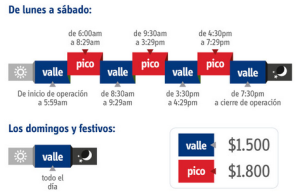
The Transmilenio bus system has a two-tiered cost structure. Riding during the off-peak time costs 1,500 Colombian Pesos or about $.62 USD. The cost during peak times is 1,800 Colombian Pesos or about $.75. You can find the latest fare information in Spanish on the official website.
How To Find Your Route
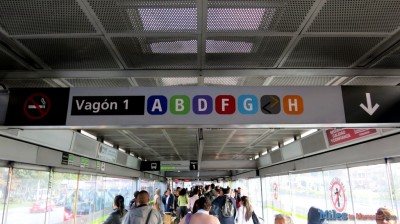
Adding to the chaos is the way the system works. When you enter a station, a number of letters are displayed corresponding to certain routes. You would think these would indicate a line like the “A” line or the “C” line. Unfortunately that isn’t the case.
There are actually dozens of different bus lines that are running at the same time. To determine which one you need, you must first find the station you are traveling to on the map. That station will be in a zone.
Once you have found the zone, then look at all bus routes that travel through or terminate in that zone. A bus routes letter is determined by which zone it terminates in. (Route F14 terminates in the F zone for example.)
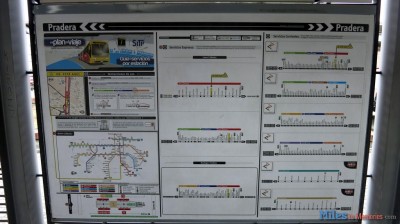
Lets say you are traveling to Pradera station in Zone F, then you must find a route that travels through or terminates in Zone F. Since all buses don’t stop at every station within a zone, you have to consult a board in the station to see which of the routes stops at the station you need.
It sounds complicated and feels that way as well, but in reality having a lot of routes make the system more flexible and it only takes a few minutes to get used to.
In The Station
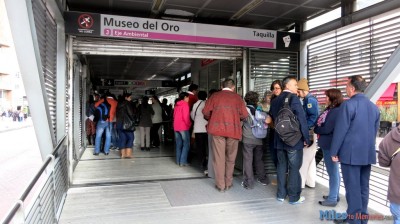
Once you have found which route you need, the waiting begins. While there are often buses every couple of minutes, during rush hour it can be difficult to get on. While no one is rude or in your face, there will always be those people who like to push and jockey for position.
Transmilenio stations are insane places as well. With buses constantly pulling up and leaving and thousands of people criss-crossing to find their routes, it is quite an experience. While we were overwhelmed at first, it only took a few minutes to become pros at figuring out where we were going and how to get there.
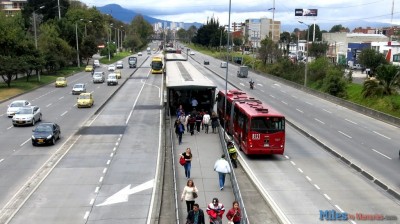
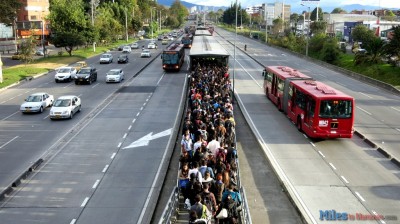
One thing to learn and keep in mind as a tourist is that some stations do not have ticket booths. This is a problem for two reasons. During the busy times, the stations that do have booths can develop very long lines. Ok, incredibly long lines.
Also, if you happen to be stuck at a station without a ticket booth and don’t have a prepaid card, you are kind of out of luck. We only ran into this twice at secondary stations, but it wasn’t much of an issue. Luckily stations aren’t too far apart and we were able to walk about five minutes to a place where we could buy a ticket.
Safety
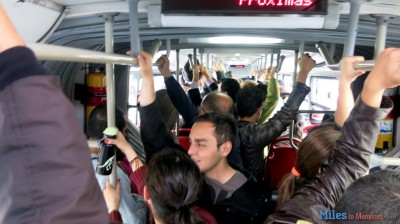
Safety is a concern in Bogota just like any large city. You should always use caution and know where you are going. We never once felt in danger riding the Transmilenio buses and there were always plenty of people around which added to the safety factor as well.
Any time you are on crowded public transport, pickpocketers become an issue. It is important to watch your pockets and protect your valuables on the Transmilenio, but I could say the same thing about every crowded public transport system around the globe. Be careful, be aware and everything should be fine.
Conclusion
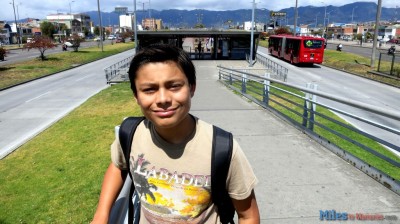
If you are going to visit Bogota, then a ride on their Transmilenio system is a must. It is a chaotic experience and one that isn’t always comfortable and fun, but there is no better way to see the locals going about their lives. If you speak Spanish then you may even make some new friends!
For families, this is the way to see and get around Bogota, especially if your children are a little older. They will always remember the sensory overloading experience of the Transmilenio. In the end, whether traveling as a family or by yourself, you really shouldn’t visit Bogota without taking at least one ride on the amazing and insane Transmilenio bus system!






Censored my very relative comment? Very classy.
No. When you haven’t posted a comment before on the blog, it is held for moderation. I just now checked the pending comments. I don’t censor comments. In the future if you have a question feel free to contact me directly or know your comment will go through.
Skip public transport altogether in bogota and use uber. Public transport is too sketchy and the marginal price difference with uber ensures a safe and efficient ride.
I actually used Uber (and wrote about it) in Colombia and don’t think there is anything wrong with it. For a single person Uber ends up being about 15x as expensive as public transport. For my family of three it was about 5x more expensive.
Sometimes when you are traveling, cost isn’t everything though. I travel to experience local culture. There is nothing more local than being on the Transmilenio. I think both Uber and public transport have their pluses and minuses, but I think someone who visits Bogota is missing out if they don’t ride the Transmilenio buses at least once.
Perhaps there is less chance of getting pick-pocketed on Uber, but I never had any safety issues on public transport in Bogota. Also, the traffic in the city is quite bad. For example on my Uber trip from the bus station to the hotel, it took about 40 minutes to go 7 miles. The Transmilenio buses run on dedicated lanes in that section and thus would have been faster.
Thanks for sharing your opinion. There is no “one right answer”.